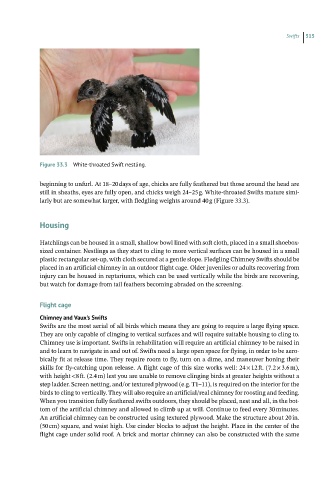Page 518 - Hand rearing birds second
P. 518
Swifts 515
Figure 33.3 White-throated Swift nestling.
beginning to unfurl. At 18–20 days of age, chicks are fully feathered but those around the head are
still in sheaths, eyes are fully open, and chicks weigh 24–25 g. White-throated Swifts mature simi-
larly but are somewhat larger, with fledgling weights around 40 g (Figure 33.3).
Housing
Hatchlings can be housed in a small, shallow bowl lined with soft cloth, placed in a small shoebox-
sized container. Nestlings as they start to cling to more vertical surfaces can be housed in a small
plastic rectangular set-up, with cloth secured at a gentle slope. Fledgling Chimney Swifts should be
placed in an artificial chimney in an outdoor flight cage. Older juveniles or adults recovering from
injury can be housed in reptariums, which can be used vertically while the birds are recovering,
but watch for damage from tail feathers becoming abraded on the screening.
Flight cage
Chimneyand Vaux’sSwifts
Swifts are the most aerial of all birds which means they are going to require a large flying space.
They are only capable of clinging to vertical surfaces and will require suitable housing to cling to.
Chimney use is important. Swifts in rehabilitation will require an artificial chimney to be raised in
and to learn to navigate in and out of. Swifts need a large open space for flying, in order to be aero-
bically fit at release time. They require room to fly, turn on a dime, and maneuver honing their
skills for fly-catching upon release. A flight cage of this size works well: 24 × 12 ft. (7.2 × 3.6 m),
with height <8 ft. (2.4 m) lest you are unable to remove clinging birds at greater heights without a
step ladder. Screen netting, and/or textured plywood (e.g. T1–11), is required on the interior for the
birds to cling to vertically. They will also require an artificial/real chimney for roosting and feeding.
When you transition fully feathered swifts outdoors, they should be placed, nest and all, in the bot-
tom of the artificial chimney and allowed to climb up at will. Continue to feed every 30 minutes.
An artificial chimney can be constructed using textured plywood. Make the structure about 20 in.
(50 cm) square, and waist high. Use cinder blocks to adjust the height. Place in the center of the
flight cage under solid roof. A brick and mortar chimney can also be constructed with the same

